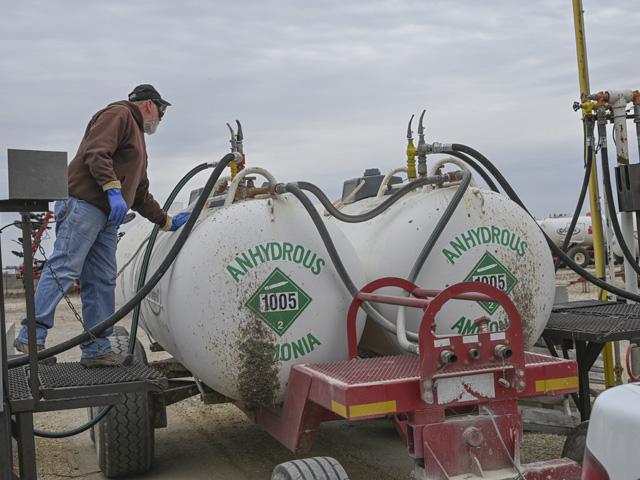Nitrogen Calculations Made Easy
Nitrogen Math and Tools Help Farmers Determine Optimum Rates
ANKENY, Iowa (DTN) -- It's time for farmers to sharpen those nitrogen math skills as they decide how much to buy for the 2023 corn crop.
Many farmers buy all or a portion of their nitrogen (N) needs months in advance when demand is low and prices are hopefully cheaper. Today's near record-high fertilizer prices could be cheaper than in the spring given the uncertainty of future corn and natural gas prices -- the primary drivers of N costs.
After deciding what N products to use next year, Jeff Vetsch, a University of Minnesota soil scientist, said determining how much nitrogen to buy is basically a two-step process:
-- Determine target N rates.
-- Use nitrogen math formulas to calculate how much N to buy.
"I think that farmers want to start with the MRTN (Maximum Return to Nitrogen) calculator to look at optimum rates and see how they compare to what they are currently applying," said Vetsch. "Once you are comfortable with a rate, then you do the math."
MRTN
Corn growers in Wisconsin, Indiana, Iowa, Minnesota, Michigan, Illinois and Ohio can use the research-based MRTN calculator. Find the calculator at http://cnrc.agron.iastate.edu/….
Users input data on the previous crop, corn price and N price to find an N rate that will provide the best economic return. The calculator uses decades of research trial data from each state or region within a state. The online tool is continually updated with latest year's data.
P[L1] D[0x0] M[300x250] OOP[F] ADUNIT[] T[]
Vetsch said the days of applying 1 pound or more of N per acre to get one bushel of corn, which was standard practice decades ago, are long gone. He said N-use efficiency of today's corn hybrids have greatly improved, as well as grower management. There's no set per-acre N-to-bushel ratio anymore. He said N-rate trials in Iowa and Minnesota indicate 160 pounds of N per acre, for example, can now produce 300-bushel-per-acre corn.
"Total N uptake in a corn plant probably hasn't changed a whole lot over the last 30 years, but the concentration of N in grain is less today," he stated. "The price ratio (between N and corn prices) is a big deal right now. The ratio suggests that more profitable N rates would be on the lower side (of the MRTN range)."
Farmers in states that don't participate in the MRTN program should check with their state university's Extension division or search the division's site for fertilizer/nutrient calculations. The common denominator is each state's recommendations are based on in-field research on the soil types and conditions of that state.
Central Iowa farmer Ian Plagge found the optimum N rate on his farm for corn-after-soybeans and continuous corn is 0.8 pounds per acre and 1 pound per acre, respectively, for every expected bushel. That's the plan for 2023 as well.
"It's a good place to start. A big part of our plan (next year) is doing more soil nitrate tests," Plagge said, which could indicate less N is needed.
Here are N math formulas for various N products (an N target rate of 140 pounds per acre is used as an example):
-- Anhydrous ammonia (82-0-0 or 82% N): Divide 140 pounds by 0.82 = 171 pounds per acre.
-- Urea (46-0-0 or 46% N): Divide 140 by 0.46 = 304 pounds per acre.
-- UAN28 (28-0-0 or 28% N): UAN28 weighs 10.7 pounds per gallon, so 10.7 X 0.28 = 3 pounds of N per gallon. Divide 140 by 3 = 46.7 gallons per acre.
-- UAN32 (32-0-0 or 32% N): UAN32 weighs 11.06 pounds per gallon, so 11.06 x 0.32 = 3.5 pounds of N per gallon. Divide 140 by 3.5 = 40 gallons per acre.
-- MAP (monoammonium phosphate, 11-52-0 or 11% N and 52% P): 1 pound X 0.11 = 0.11 pounds of N per pound of MAP. If spreading 200 pounds of MAP per acre, 22 pounds of N was applied (200 X 0.11).
-- DAP (diammonium phosphate, 18-46-0 or 18% N and 20% P): 1 pound X 0.18 = 0.18 pounds of N per pound of DAP. If spreading 200 pounds of DAP per acre, 36 pounds of N was applied (200 X 0.18).
Here are other DTN fertilizer stories to check out:
-- www.dtnpf.com/agriculture/web/ag/news/article/2021/06/03/nitrogen-math
-- www.dtnpf.com/agriculture/web/ag/crops/article/2022/10/26/take-steps-optimize-fall-fertilizer
-- www.dtnpf.com/agriculture/web/ag/crops/article/2022/10/25/12-safety-tips-working-anhydrous
Matthew Wilde can be reached at matt.wilde@dtn.com
Follow him on Twitter @progressivwilde
(c) Copyright 2022 DTN, LLC. All rights reserved.






